How Intent-Based Marketing Can Supercharge Growth for B2B Tech Startups
Why This Matters for Startups
Intent-based marketing isn’t just another buzzword. For B2B tech startups trying to grow on limited budgets, it’s a total game-changer. Instead of throwing money at broad campaigns and hoping something sticks, you can focus on people who are already looking for what you offer. When you show up at the right moment with the right message, the results speak for themselves – more qualified leads, higher conversions, and less wasted spend.
What Is Intent-Based Marketing, Really?
In simple terms, intent-based marketing means going after people who are showing signs they’re ready to buy. That could be anything from searching key terms, checking out your pricing page, downloading a whitepaper, or asking for advice on Reddit. These signals tell you who’s in the market right now, so you can spend your time and money where it actually counts.
Why It’s a Perfect Fit for B2B Tech Startups
- You Get More from Your Budget: You’re targeting people already interested.
- Deals Close Faster: You’re meeting prospects when they’re ready to talk.
- Better Teamwork: Sales and marketing work off the same signals.
- Stay Ahead of Competitors: You get in front of buyers before others even know they’re looking.
What Intent Data Looks Like
- First-Party: Info from your own site and tools – think pricing page visits, email clicks, webinar sign-ups.
- Second-Party: Data from trusted platforms like G2 or TrustRadius.
- Third-Party: Broader data from sources like Bombora or 6sense – collected across the web.
- Community & Social: Conversations on LinkedIn, Reddit, Twitter, YouTube, Stack Overflow – great for spotting active research.
- Event-Based: Someone who signs up for your demo or joins an industry webinar is giving off a clear buying signal.
Each type plays its part – first-party is super accurate, second-party adds context, third-party gives you reach, and social/event-based data brings real-time urgency.
How to Build an Intent-Based Strategy That Works
- Start with Your Ideal Customer: Know who you’re trying to reach.
- Watch for Signals: Use tools like HubSpot, Google Analytics, or social platforms to spot buyer behavior.
- Sort Your Leads: Focus on the strongest signals first – a demo request means way more than just reading a blog.
- Make It Personal: Send messages that match where someone is in their buying journey.
- Keep Sales and Marketing in Sync: Share data, align your outreach, and track what’s working.
- Keep Tuning: Use results to fine-tune your messaging and targeting.
What This Looks Like in Real Life
- LinkedIn Outreach: A SaaS startup spots interest in “data visualization” and sends tailored messages to people engaging with related posts.
- Smart Content Funnels: A cybersecurity company targets users searching for “ransomware defense” with helpful whitepapers and follow-ups.
- Retargeting Ads: A project management tool shows ads only to companies who checked out their pricing page or joined a recent demo.
- Forum Listening: A devtool startup tracks keywords like “CI/CD bottlenecks” on forums and jumps into the conversation.
Budget-Friendly Tips for Startups
- Use free tools like Google Search Console, Hootsuite, or HubSpot’s free CRM.
- Pay attention to what’s being said on LinkedIn, Reddit, Quora, and Twitter.
- Track who signs up for your events or webinars and follow up.
- Pick a few high-intent keywords and keep your Google Ads super focused.
Bottom Line: Be Smarter, Not Louder
You don’t need a huge budget to make a big impact. Intent-based marketing helps you work smarter by focusing on the right people at the right time. It’s not about shouting louder – it’s about knowing who’s already listening.
More growth strategies coming soon – stay tuned.

